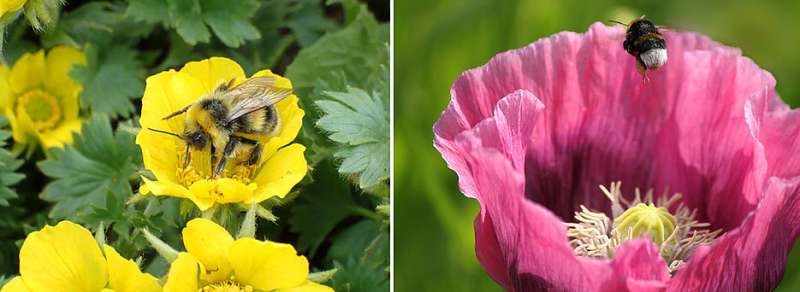This article has been reviewed according to Science X's editorial process and policies. Editors have highlighted the following attributes while ensuring the content's credibility:
fact-checked
peer-reviewed publication
trusted source
proofread
Study finds flower patterns make bumblebees more efficient

The search for nectar costs insects a lot of energy, so they have to be as efficient as possible. Colorful patterns on the petals can help with that.
Be it mallow, foxglove or forget-me-not: many flowers bear colorful patterns, which are known as nectar guides in biology. They are assumed to show the pollinating insects the shortest way to the nectary. This guiding function could increase the efficiency of the insects in their search for food, and at the same time improve the pollen dispersal of the plant.
A team from the Biocentre of Julius-Maximilians-Universität Würzburg (JMU) in Bavaria, Germany, has now deciphered the individual steps through which flower patterns increase the efficiency of terrestrial bumblebees (Bombus terrestris) for the first time. They demonstrate that nectar guides reduce the time needed for the bee's entire interaction with a flower by up to 30%—from approach to finding the nectar to departure.
What the flower patterns do
Surprisingly, flower patterns do not shorten the actual nectar search: After landing on a patterned flower, the bumblebees did not find the nectar any faster than on a flower without a pattern. However, the flower patterns shortened the approach flight time and ensured a strategically favorable landing position. Thus, they act like markings on a runway and help the bumblebees to coordinate their approach, reports the team led by Anna Stöckl and Johannes Spaethe in the journal Functional Ecology.
Flower patterns also shorten the time until take-off: the insects stayed significantly shorter on patterned flowers after collecting nectar. "Bumblebees very often run to the edge of the petals for take-off," says Johannes Spaethe. They may find this take-off site more quickly if they can orient themselves to a pattern.
This study was conducted using video tracking. The bumblebees visits to artificial flowers were analyzed in the laboratory. The artificial flowers presented different pattern types or none at all; all of them had nectar on them.
Next, the JMU team will investigate how the glossy surface that occurs on some flowers affects the interaction with pollinating insects.
More information: Robin Richter et al, Flower patterns improve foraging efficiency in bumblebees by guiding approach flight and landing, Functional Ecology (2023). DOI: 10.1111/1365-2435.14262
Journal information: Functional Ecology
Provided by Julius-Maximilians-Universität Würzburg




















